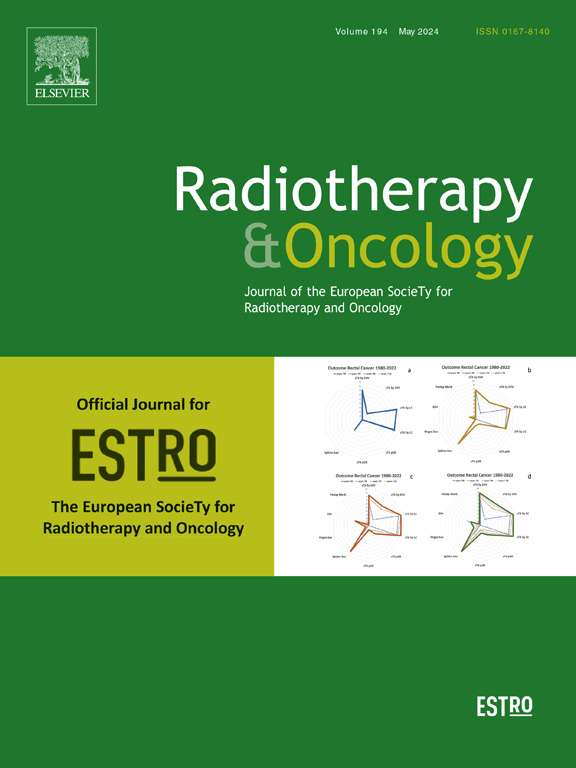Neuroprotection in radiotherapy of brain metastases – a European pattern-of-care analysis by the ESTRO CNS Focus group
IF 4.9
1区 医学
Q1 ONCOLOGY
引用次数: 0
Abstract
Background and purpose
Preservation of neurocognitive function is gaining importance for patients with brain metastases (BM). Several methods of neuroprotection in radiotherapy of BM have been developed and tested in prospective clinical trials, including stereotactic radiotherapy (SRT), hippocampal-sparing whole-brain radiotherapy (HS-WBRT) and concomitant memantine. The present analysis aimed to assess the current treatment patterns in European countries.
Materials and methods
We distributed an online survey among radiation oncologists (ROs) registered within the European Society for Radiotherapy and Oncology (ESTRO). Questions included characteristics of treatment centers and institutional standard operating procedures, focusing on the use of neuroprotective measures.
Results
The survey was completed by 234 ROs from 31 countries. WBRT is the preferred treatment modality over SRT for 4–5 BM for 18 % and for 6–10 BM for 53 % of ROs. While HS-WBRT is generally offered by most ROs (85 %), only a minority apply the technique regularly (25 %), and prescription parameters vary considerably. Concomitant memantine is prescribed by 30 % of ROs. Besides concerns about available evidence, limited staff capacity and reimbursement issues constitute frequent obstacles. Boost treatments as part of WBRT are rarely performed on a regular basis (22 %). Prognostic scores are used by a majority of ROs, while cognitive tests are not. There were significant differences between higher- and lower-income countries, and between university hospitals and other centers.
Conclusion
There is considerable heterogeneity regarding neuroprotective radiotherapy approaches in European countries and regular application is limited. Besides clinical trial results, improved technical availability and reimbursement might be required to improve their utilization for BM treatment.
脑转移放疗中的神经保护- ESTRO CNS焦点组的欧洲护理模式分析
背景与目的脑转移瘤(BM)患者神经认知功能的保护越来越重要。脑脊髓炎放疗中的几种神经保护方法已经开发出来,并在前瞻性临床试验中进行了测试,包括立体定向放疗(SRT)、保留海马的全脑放疗(HS-WBRT)和伴随的美金刚。本分析旨在评估欧洲国家目前的治疗模式。材料和方法我们在欧洲放射治疗和肿瘤学会(ESTRO)注册的放射肿瘤学家(ROs)中进行了在线调查。问题包括治疗中心的特点和机构标准操作程序,重点是神经保护措施的使用。结果本次调查由来自31个国家的234名注册会计师完成。相对于SRT, WBRT对4-5个脑损伤的治疗效果为18%,对6-10个脑损伤的治疗效果为53%。虽然HS-WBRT通常由大多数ro提供(85%),但只有少数ro定期使用该技术(25%),处方参数差异很大。30%的ROs同时使用美金刚。除了对现有证据的关切外,有限的工作人员能力和报销问题也经常构成障碍。作为WBRT一部分的强化治疗很少定期进行(22%)。大多数ROs使用预后评分,而认知测试则不使用。在高收入国家和低收入国家之间,以及在大学医院和其他中心之间存在显著差异。结论欧洲国家神经保护放疗入路存在较大的异质性,常规应用有限。除了临床试验结果外,可能还需要改进技术可用性和报销,以提高它们在脑脊髓炎治疗中的利用率。
本文章由计算机程序翻译,如有差异,请以英文原文为准。
求助全文
约1分钟内获得全文
求助全文
来源期刊

Radiotherapy and Oncology
医学-核医学
CiteScore
10.30
自引率
10.50%
发文量
2445
审稿时长
45 days
期刊介绍:
Radiotherapy and Oncology publishes papers describing original research as well as review articles. It covers areas of interest relating to radiation oncology. This includes: clinical radiotherapy, combined modality treatment, translational studies, epidemiological outcomes, imaging, dosimetry, and radiation therapy planning, experimental work in radiobiology, chemobiology, hyperthermia and tumour biology, as well as data science in radiation oncology and physics aspects relevant to oncology.Papers on more general aspects of interest to the radiation oncologist including chemotherapy, surgery and immunology are also published.
 求助内容:
求助内容: 应助结果提醒方式:
应助结果提醒方式:


